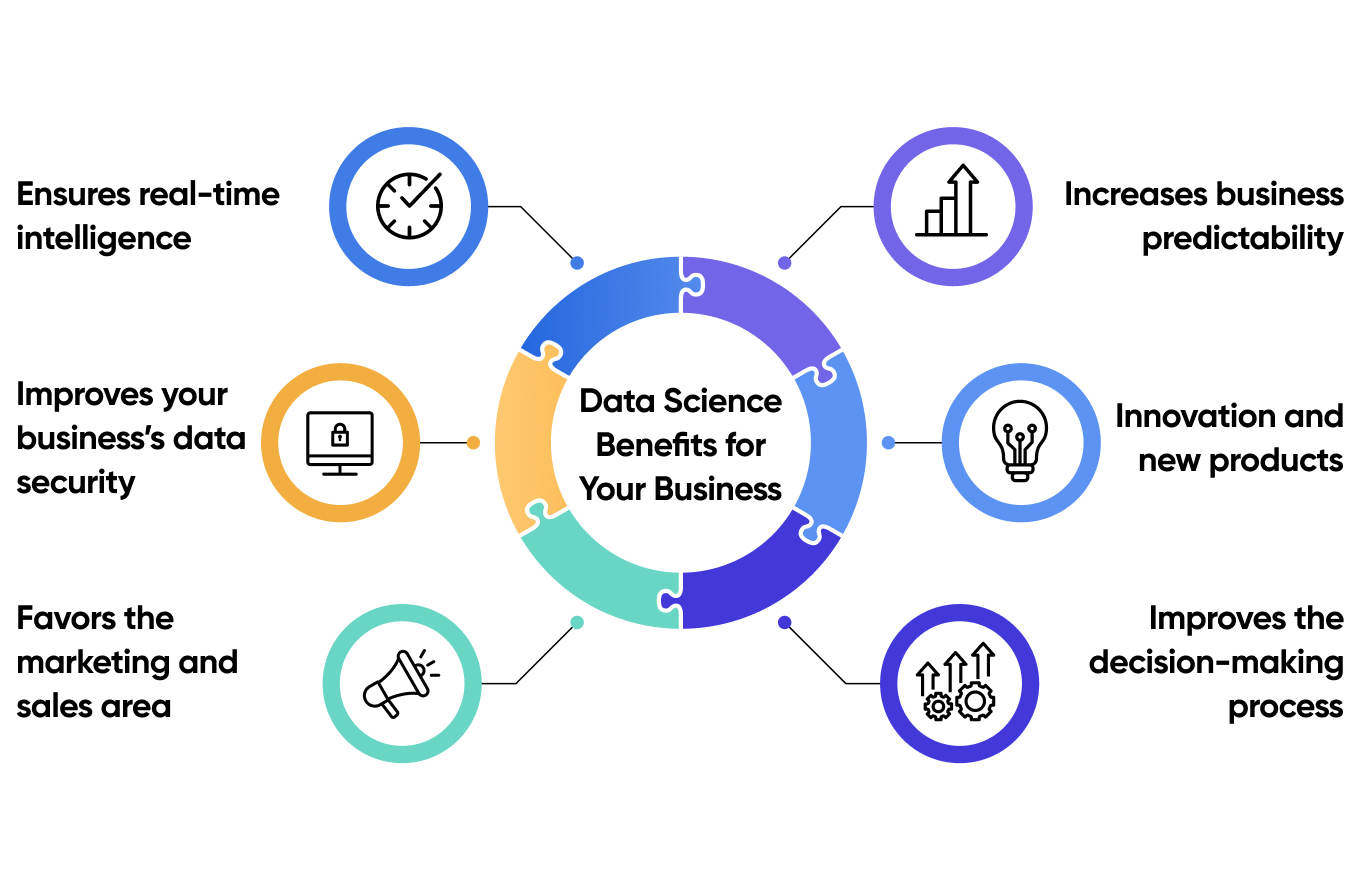What are the Uses of Data Science & How Does it Help Businesses?
Table of Contents

- jaro education
- 29, February 2024
- 10:00 am
Data science has emerged as a pivotal field for businesses due to the exponential growth in data generation and opportunities to derive impactful insights from it. It broadly encompasses extracting powerful intelligence from data by applying techniques like predictive modelling, machine learning, statistics, natural language processing, and data visualisation. The manifold uses of data science for businesses include enabling more informed decision-making, optimising critical processes, developing innovative products and services, enhancing customer experiences, reducing risks, and driving growth.
Data science techniques and capabilities must be strategically embraced across marketing, operations, finance and other business functions, to gain sustainable and competitive advantage in the digital era. For that reason, this blog will explore some of the most versatile, practical applications of data science in business and explain how leaders across industries can harness its far-reaching potential.
Necessity of Data Science in Businesses
There’s no denying the indispensable role data science now plays across industries and business functions. With the exponential growth in data generation and availability, leveraging data science has become imperative for companies to gain a competitive advantage and drive growth. Simply put, organisations that fail to effectively harness data science risk losing out to more analytically-driven competitors.
Just look around at the companies leading their fields – from tech giants like Google and Amazon to disruptive startups, data science powers everything from strategic planning to day-to-day operations. And it’s no longer just for tech companies. Data science is now embedded in various forms across banking, healthcare, retail, manufacturing, and more to inform better decision-making.

*softformance.com
For instance, banks employ data science techniques like predictive modelling and machine learning algorithms to improve risk assessment, detect fraud faster and offer personalised recommendations to customers. Hospitals leverage real-time analytics to improve patient outcomes and lower costs. Retailers analyse customer data to optimise pricing, marketing, and inventory planning, and enhance overall shopping experiences.
The benefits are tremendous – data science allows businesses to identify unseen patterns and connections, gain actionable insights, preempt issues, and guide strategies. It leads to higher operational efficiency, improved products and services, lower costs, better targeting, and increased revenues. In a nutshell, data science unlocks immense potential for any organisation to outperform competitors. As data volumes grow exponentially, businesses of all sizes must start leveraging data science, even with limited resources.
To be precise, no contemporary business seeking to maximise success can afford to ignore data science.
Advantages Businesses Can Witness by Adopting Data Science Techniques
Data science plays an instrumental role in guiding business success in the digital age by enabling data-driven decision-making, optimising critical processes, enhancing customer experiences and developing innovative offerings. Some key uses of data science include
Obtain Granular Customer Insights
Analysing large volumes of behavioural data around interests, demographics, past purchases, content views and more provides a very deep and granular understanding of customers. This enables companies to serve and market to customers in a more personalised and impactful way. Sentiment analysis can detect customer pain points and dissatisfaction signals. Churn prediction models identify at-risk customers so retention efforts can be targeted.
Strengthen Security
Combining data science algorithms with appropriate human oversight enables much tighter security and responsible data use. Data science and AI bolster threat detection capabilities, fraud analytics and risk modelling by leveraging enormous volumes of cybersecurity-related information that would be impossible for humans to process manually.
Streamline Financial Reporting
Data science and AI can assist finance teams in generating more insightful, accurate and timely financial reports, forecasts and projections. By identifying patterns and trends in historical data, data science enables finance to base budgets and performance projections on data-driven models rather than solely on intuition. This enhances executive decision-making.
Improve Manufacturing Efficiency
By building models to analyse vast flows of production data, data science can accurately spot operational bottlenecks and inefficiencies so they can be addressed. It also enables predictive maintenance to minimise unplanned outages and downtime. Over time, this allows manufacturers to optimise systems to be self-regulating and responsive to changes.
Predict Market Trends
Monitoring and analysing target audience behaviour using data science and AI equips businesses to forecast emerging changes in consumer demand and industry trends faster and more reliably than relying on traditional market research alone. This allows companies to adapt their strategies and offerings to dynamic market conditions quicker than the competition.
Applications of Data Science in Businesses
With data permeating every function, leveraging analytics is now indispensable for business growth. However, simply collecting data is not enough – companies must employ data science strategically to maximise value. Here are some tips on using data science to spur growth:
- Integrate data science into key business processes like marketing, operations, and product development. For instance, use customer analytics to create targeted campaigns, streamline supply chains through optimisation algorithms, and customise offerings based on usage patterns. This embedded application of data science will directly impact revenues and costs.
- Build an enterprise-wide data-driven culture. Provide training in analytics and data interpretation skills for employees at all levels. Create cross-functional data science teams. Leadership must actively champion data-based decision-making. Reward data-backed insights and initiatives as promoting an analytical mindset ensures widespread adoption.
- Modernise your data architecture by creating centralised repositories, implementing cloud analytics, and upgrading BI tools. Clean, integrated data is the bedrock for impactful models. Democratising access to data and analytics empowers employees to tap insights anytime.
- Clearly define the business objectives you want data science to achieve – whether it’s higher conversion rates, improved productivity or lower customer churn. This drives focus and accountability in data initiatives. Continually evaluate data ROI and tweak models to optimise outcomes.
- Start small but think big. Pursue low-hanging fruit projects like using sentiment analysis for marketing. But also plan long-term initiatives like predictive maintenance. Quick wins demonstrate tangible benefits, while ambitious efforts deliver transformative impact.
- Keep abreast of new developments in data science like machine learning and leverage them for an edge. For instance, harness neural networks to uncover hidden patterns. Experiment with emerging techniques via pilot projects. Upskill teams accordingly. Staying at the forefront of data science capabilities will turbocharge growth.
- Adopt an agile approach. Use sprints, swift prototyping and user feedback loops rather than long development cycles. This allows faster refinement of data products. Fail fast, learn quickly.
Top 5 Business Trends Associated with Data Science
Enabling Business Growth and Process Automation
Data science unlocks immense potential for driving growth by revealing customer insights and market gaps guiding new product development. It also allows leaner operations via forecasting models optimising workflows, inventory etc. Automating reporting provides real-time performance visibility.
Powering Intrinsic Concept Innovations
Analysing aggregated data on usage patterns and consumer sentiment provides the ‘jobs to be done’ perspective for developing offerings that best resonate with user needs. Data aids rapid prototyping
Driving Scalable AI and Big Data Capabilities via Cloud
As data generation scales exponentially across IoT sensors, transactions etc. cloud platforms like AWS, Azure and GCP provide virtually unlimited and affordable infrastructure for storage, processing and low-latency access to train algorithms at scale.
Boosting Competitiveness via Enhanced Decision Making
Data science equips businesses to make more informed decisions at speed and scale. Predictive models guide strategies, computer vision and NLP enable intelligent interfaces and graph analytics to find connections.
Enabling Decentralised Architectures like Blockchain
Blockchain shows immense potential with data science for disruptive Dapps across finance, supply chains etc. Smart contracts can execute analytical model predictions enabling decentralised AI, which can enhance Data integrity.
While data science unlocks such opportunities, effectively leveraging it requires overcoming associated people, process and technology adoption barriers through strong vision and governance. With responsible data usage, data science promises immense economic and social value creation potential ahead similar to past general-purpose technologies like electricity and the internet.
Conclusion
Data science is integral in enabling smarter decisions, optimised processes and data-driven innovation across countless industries. Its adoption promises immense opportunity for top-line growth, cost efficiency, customer intimacy and competitive resilience. With a strong leadership commitment to develop in-house capabilities and a data-driven culture, companies can harness data science to shape the next wave of economic and social progress much akin to past technological innovations like electricity and the internet.
So, if you want to enhance your skills in data science, IIM Nagpur’s PG Certificate Programme in Data Science for Business Excellence and Innovation is here to empower you to leverage analytics at scale. Learn from IIMN’s world-class faculty real-world applications across functions through an immersive curriculum. Master techniques in predictive modelling, optimisation, and machine learning using Python, R, and SQL and boost your career growth and business impact multi-fold through this high-impact data science in business programme from IIM Nagpur. Apply now for the upcoming batch.
Frequently Asked Questions
Cybercriminals are continuously improving their attacking abilities with the help of AI. Now they are launching large-scale attacks by integrating AI technologies into their workflows. To prevent these attacks, you should utilise AI to analyse large volumes of data, reducing false positives from security alerts and cutting out bottlenecks from security alerts.
The major benefits of AI-based cybersecurity include –
- Quickly analysing large volumes of data
- Automating the repetitive cybersecurity tasks
- Predicting potential attacks and providing messages to the security teams
To become a professional in AI cybersecurity, you need knowledge about ML data modelling, language modelling, behaviour analysis, and deep neural networks. For cybersecurity, you need a clear understanding of network security, cryptography, malware detection, data protection, and computer forensics.
No, AI can perform specific tasks in cybersecurity, but it can’t completely replace human input.
Yes, the cybersecurity professionals can automate the mundane tasks with the help of AI.
| Basis | Perfect Competition | Monopoly |
|---|---|---|
| Number of Sellers | firms | Single firm |
| Barriers to Entry | Very low | Very high |
| Substitute Products | Good substitutes are readily available | No good substitutes are available |
| Competitive Strategy | Firms compete through prices only | Companies compete through product features, quality, advertising, and marketing |
| Pricing Power | Negligible, dependent on supply and demand | Significant, companies can manipulate prices as desired |








